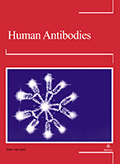Authors: Liao, Shuen-Kuei | Horton, Linda | Flahart, Robert E. | O'Rear, Lynda | Crumpacker, Dina | Imbaratto, John W. | Yannelli, John R. | Robinson, Randy R. | Oldham, Robert K.
Article Type:
Research Article
Abstract:
Recombinant DNA techniques were utilized successfully to join the coding regions for the variable region of a mouse anti-tumor antibody (BA-Br-1) and the human IgG1 constant region for both the light and heavy chains. After insertion into a mouse myeloma host cell line, the chimeric genes were expressed successfully and the resulting antibody (ING-1) was purified. In this study, we describe biochemical, serological, immunohistochemical, and functional properties of the chimeric ING-1 antibody. Analysis of the synthesized antibody revealed that while it was similar in size to the mouse antibody, it had a different pI as determined by isoelectrofocusing. The flow
…cytometric binding profiles of the new molecule were found to be essentially identical to the parental mouse immunoglobulin. The specificity of the chimeric ING-1 and mouse BA-Br-1 antibodies were compared by extensive immunohistochemical analysis on human normal and tumor tissues. The chimeric antibody retained the same broad carcinoma binding activity, showing strong reactivity with greater than 90% of epithelial tumor tissues, as was previously observed for the mouse BA-Br-1 antibody. The chimeric and mouse antibodies also recognized the same selected normal tissues: primarily glandular epithelia, gastrointestinal mucosa, bile ducts, and thyroid follicles. Analysis of the biological function of the chimeric antibody revealed that it possessed ADCC activity against antigen-bearing tumor targets in vitro which was absent from the mouse form of the antibody. Competent effector cells could be either PBMCs from normal healthy donors, PBMCs from cancer patients receiving LAK/IL-2 therapy, or LAK cells prepared from cancer patients. Enhanced cytotoxicity even in the presence of LAK cell killing was noted with effector cells from the latter two sources. This contrasts sharply with the absence of activity in the same systems when the native murine antibody was used. The in vitro activation of cell-dependent cytolysis observed with the chimeric antibodies when effector cells from both normal and tumor-bearing donors were used strongly suggests that comparable activity would be observed in vivo. These results, along with the broad carcinoma binding activity and minimal normal tissue reactivity, suggest that the ING-1 chimeric antibody may be useful in cancer therapy. The application of the ING-1 chimeric antibody for treatment of tumors thus offers a promising avenue for future research.
Show more
Keywords: chimeric antibody, carcinoma, binding, ADCC, IL-2, LAK cells
DOI: 10.3233/HAB-1990-1201
Citation: Human Antibodies,
vol. 1, no. 2, pp. 66-76, 1990
Price: EUR 27.50




